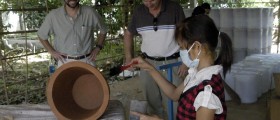It is a widespread belief that the cure for herpes can be found in colloidal silver. Herpes belongs to one of the sexually transmitted diseases and it is transferred with the virus Herpes simplex. The number of people in the USA who have been affected by herpes is alarmingly growing and according to the statistics, every fourth person has experienced it.
Sadly, there isn’t a cure for herpes; the symptoms may be cured, but the virus remains in a person’s body. Due to the incapability of modern medicine to discover a cure for herpes, people turn to alternative medicine and its advantages. Colloidal silver is said to be a cure for herpes and many other diseases.

Why Isn't There a Cure for Herpes?
Herpes is present in our society for many years, but still, doctors weren’t able to discover a cure for it. It is mainly because when doctors prescribe antiviral medications, the virus is already in the nerve cells, protected, and the drugs can’t reach it. These drugs can’t follow the virus and fail to find it, but on the other hand, the symptoms ease and eventually disappear.
Then we think that it is all over, that we are cured, but the moment our immunity becomes weak, the virus attacks again and symptoms reappear and the whole cycle starts again. But, as the virus is constantly changing and improving, it becomes more and more resistant to antiviral drugs.
Can Herpes be Cured with Colloidal Silver?
Colloidal silver has a different impact on the herpes virus than antibiotics. In this particular case, colloidal silver has a function of a catalyst with the enzymes that are necessary for the breathing of bacteria and viruses. So, when something enables them to breathe, they die.
Colloidal silver has proved to be very effective in inflammation reduction and promotion of injured tissue healing. The fact that colloidal silver has an effect on microorganism enzymes and nothing else is really fascinating.
- Herpes simplex virus (HSV) causes a contagious infection affecting approximately 60% to 95% of adults worldwide. HSV-1 is associated mainly with infections of the mouth, pharynx, face, eye, and central nervous system (CNS), while HSV-2 causes infections of the anogenital area.
- Recently, antiviral properties of AgNPs have been reported during in vitro studies with HIV-1, HBV, and influenza virus. Lara et al. (2010) showed that AgNPs can bind to one of the HIV surface glycoprotein (gp120) and inhibit virus-to-cell attachment. Baram-Pinto et al. (2009) used mercaptoethane sulfonate capped AgNPs to inhibit HSV-1 attachment to cell host membrane and thus infection.
- All nanoparticles used in this study were synthesized by chemical reduction method using silver nitrate (AgNO3) purity 99.999% (Sigma-Aldrich, St. Louis, MO, USA), sodium citrate (C6H5Na3O7*2H2O) purity 99.0%, (Sigma-Aldrich), tannic acid (C76H52O46) (Sigma-Aldrich) and sodium borohydride (NaBH4, purity ?96%) (Sigma-Aldrich).
- Synthesized silver colloids were examined using a Dynamic Light Scattering technique (DLS). The size and size distribution of particles in the colloids were measured using a Nano ZS zetasizer system (Malvern Instruments, Worcestershire, United Kingdom). The measured parameters were as follows: a laser wavelength of 633 nm (He-Ne), a scattering angle of 173°, a measurement temperature of 25°C, a medium viscosity of 0.8872 mPa*s, and a medium refractive index of 1.330.
- The HSV-2 strain 333 was obtained from B. Adamiak, Department of Clinical Virology, Göteborg University, Göteborg, Sweden and propagated in African green monkey kidney cells (GMK-AH1) and titrated by the standard plaque assay (PFU/ml).
- In this study we showed that anti-viral effects of tannic-acid modified AgNPs were more efficient than the tannic acid itself in carrier buffers in terms of blocking virus attachment, penetration and cell-to-cell spread after initial infection. Furthermore, tannic acid modified AgNPs were better antivirals for in vivo infection, also for treatment.
How to Use Colloidal Silver for Herpes?
This method of treatment is not yet approved and there are still some confusing things that have to be defined. People who get in the middle of herpes treatment with colloidal silver can develop argyria, which is an irreversible condition that develops if a person has been exposed to various impure forms of silver. The symptom of this condition is bluish tinting of the skin, and there isn’t a cure for it. The only thing that can be done is to localize argyria.
But, if you are using pure silver, you shouldn`t worry about argyria developing. With the help of colloidal silver, a person who has herpes can decrease the breakouts and maintain immunity strength.
- www.cdc.gov/conjunctivitis/newborns.html
- www.nih.gov/news-events/news-releases/epstein-barr-virus-protein-can-switch-risk-genes-autoimmune-diseases
- Photo courtesy of Silverliving by Wikimedia Commons: commons.wikimedia.org/wiki/File:9oz_Bottle_Colloidal_Silver_.png

















Your thoughts on this
Loading...